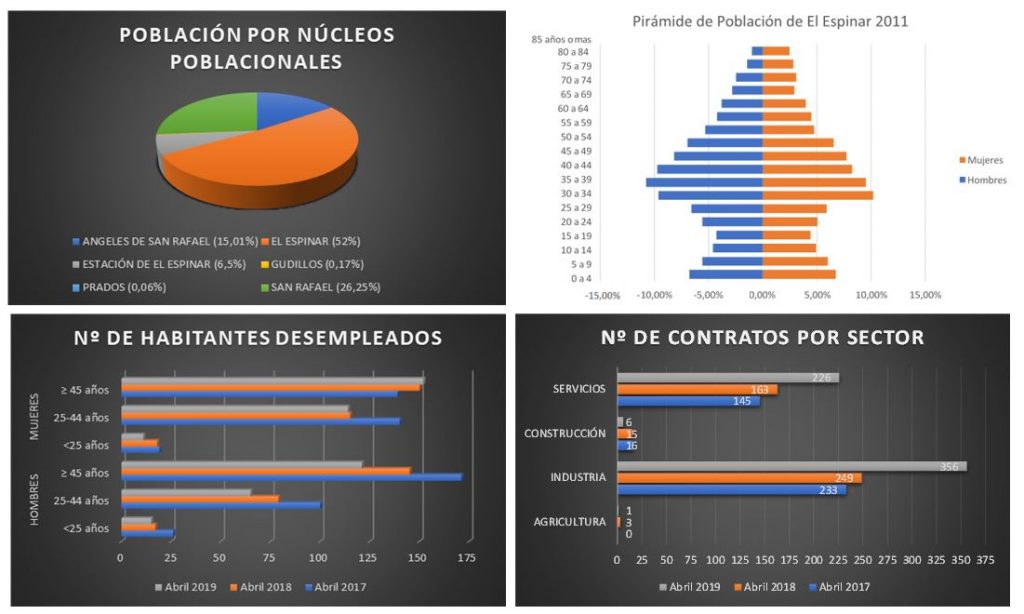Ainhoa Moral
El Espinar is a municipality located in the southwest of the province at the foot of the Sierra de Guadarrama.
It has an area of 205.10 km2, the second largest in the province after Cuéllar, through which the rivers Moros, Gudillos and Voltoya flow.
It enjoys the protection of a large part of its territory by being declared as ZEPA, LIC, as well as being within large protected areas such as the Sierra de Guadarrama National Park, the Real Sitio de San Ildefonso-El Espinar Biosphere Reserve.

Picture 1: Graphs – Own elaboration with data provided by the City Council of El Espinar (26/11/2020), by the INE or by SEPE´s website
It currently has a total population of 9,965 inhabitants, distributed in six population centres: El Espinar, San Rafael, Los Angeles de San Rafael, La Estación del Espinar, Gudillos and Prados.
In the graph of “population by population nucleus” we can see that there is an unequal distribution of the population, with a clearly more significant nucleus, El Espinar, with more than half of the municipal population.
In the “population pyramid” it is observed as the municipality of El Espinar is not a very old municipality. Our pyramid suffers a strangulation at the base, this is due to the fact that the young population migrates to urban areas such as Madrid, in search of new opportunities (work and / or study). There is a tendency to improve with the growth of the birth rate, which is a positive aspect for the demographic maintenance of the municipality.
As El Espinar is surrounded by three large cities such as Madrid, Ávila and Segovia, it has not suffered so much the rural exodus. Many of its working age population works in the cities but can continue to live in the municipality. For this reason, with a population of 9.965 inhabitants, we cannot speak of a depopulated municipality, even though it has nuclei such as Gudillos, which has suffered a sharp population decline.
As far as unemployment is concerned, work is being done in the municipality of El Espinar, and the number of unemployed is being reduced year by year. In the last year it has gone from having an unemployment rate of 12.56% to 11.70%, slightly below the national unemployment rate of 13.7% and, more importantly, it has fallen from last year to 12.56%. This downward trend has been repeated for several years, which is a good prognosis for years to coming years.
There is concern about the distribution by age group, where we see that it is much higher in older ages. More worrying is the case for women over the age of 25 where unemployment has hardly decreased in the last year, even increasing in women over 45 since 2017. In this sense, this dynamic is clearly different in men.
In the graph “number of contracts per sector” shows that the industrial sector is the one that signs the most contracts in the municipality, followed by the service sector. On the other hand, the agricultural sector is a sector with a strong tradition in the municipality, very consolidated, which demands little new labor, but which is the economic source for many households.
The hiring figures are not very significant and many of these contracts are temporary, caused by the arrival of good weather in April, which brings with it the influx of tourists and holidaymakers, and the need to increase recruitment to meet demand.
Whit regard to transport and connectivity, the municipality of El Espinar is located in a strategic point, due to its proximity and centrality to three provincial capitals such as Madrid (60 km away), Segovia (30 km away) and Ávila (40 km away), which are connected to the municipality by roads and motorways.
Road connections with Madrid: (journey time 45 minutes)
N-VI road.
AP-6 motorway.
Road connections with Segovia: (30 minutes drive)
N- 603 road.
AP- 61 motorway.
Road connections with Ávila (40 minutes drive)
SG-500 trailer.
As far as internal transport is concerned, El Espinar has a municipal transport service that links the main towns and has a taxi service with 9 cars for the whole municipality.
In its connections with Madrid and Segovia you can choose between two public transports such as the train or the bus.
The connection by public transport with Avila is totally non-existent.
DAFO Diagnostics:
Picture 2: Dafo- Own elaboration
